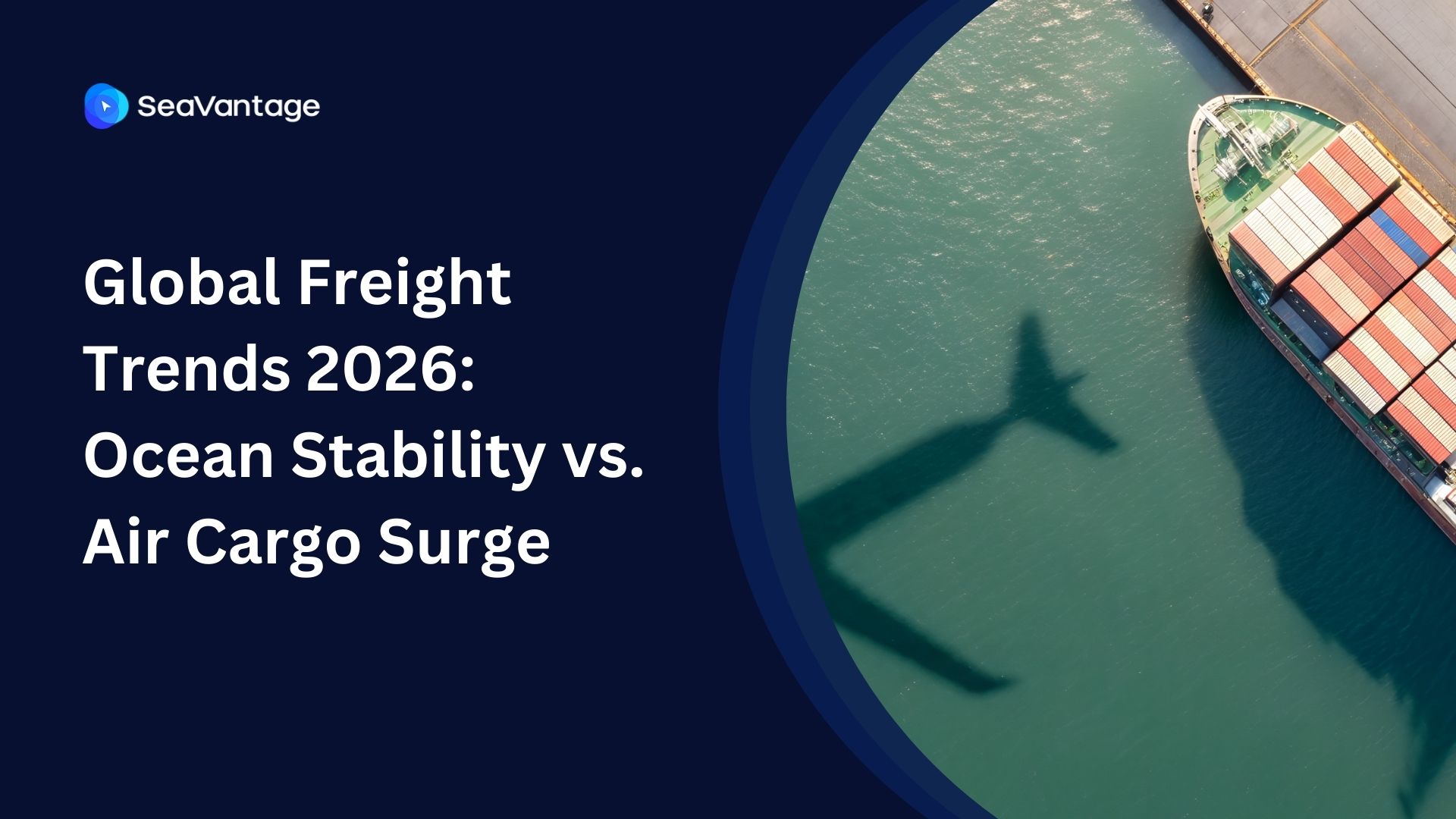Container Dwell Time Explained: Causes, Impacts, and Solutions (2025 Guide)

Introduction: Why Container Dwell Time is the Most Critical Metric in Logistics Today
In the complex world of global trade, container dwell time has emerged as a critical performance indicator. As ports grapple with fluctuating demand, infrastructure bottlenecks, and shifting regulations, the time a container spends at a terminal has direct and significant consequences on cost, reliability, and overall supply chain health.
The gap between efficient and congested ports in 2025 is staggering. SeaVantage data reveals that while some carriers in Busan and Singapore experience zero waiting time, others face over 70 hours of delays at major ports like Shanghai and Savannah. In one extreme case at the Port of Koper, a carrier endured more than 250 hours of combined waiting and working time. These figures prove that understanding and actively managing container dwell time is no longer just an operational task, it's a strategic imperative for logistics leaders.
This guide provides a comprehensive breakdown of container dwell time, explores the latest 2025 data, and offers actionable strategies to help you monitor, manage, and reduce it.
What is Container Dwell Time? The Four Key Stages
Container dwell time isn't a single metric. It's the total time elapsed during several distinct stages, each reflecting a different aspect of port and supply chain efficiency.
- Waiting Time: The hours a vessel spends anchored outside the port, waiting for an available berth. This is often the first sign of port congestion. Example: In August 2025, Wan Hai Lines waited nearly 78 hours at Shanghai before berthing.
- Working Time: The duration the vessel is docked at the berth while containers are actively being loaded and unloaded. Long working times can indicate issues with crane availability, labor, or yard capacity. Example: At the Port of Los Angeles, Maersk’s working time stretched to 165 hours in August 2025.
- Terminal Dwell Time: The period a container stays within the terminal yard after being unloaded from the vessel and before it's picked up by truck, rail, or barge.
- Street Dwell Time: The time a container spends outside the port gates, in a chassis yard or at a warehouse, before being returned empty to the port or reused for an export.
Understanding each stage is crucial for pinpointing the root cause of delays and avoiding costly demurrage and detention fees.
The Global State of Port Dwell Time: 2025 Benchmarks
SeaVantage’s monthly dwell time analyses from mid-2025 highlight a dramatic variance in performance across major global ports.
High-Performance Ports
- Busan & Singapore: These ports consistently set the global standard. Many carriers recorded zero waiting times, a testament to their streamlined operations, efficient berth scheduling, and world-class infrastructure.
Congested Ports & Hotspots
- Shanghai: Certain carriers consistently face long queues. Wan Hai Lines, for instance, reported approximately 78 hours of waiting time in August.
- Savannah: Turkon Line endured nearly 74 hours of waiting before berthing in the same month, highlighting ongoing congestion challenges on the U.S. East Coast.
Ports with Long Working Times
- Los Angeles: Maersk vessels spent roughly 165 hours being worked on in August.
- Long Beach: ONE (Ocean Network Express) recorded 143 hours of working time.
7 Key Factors Influencing Container Dwell Time
Several interconnected factors contribute to how long a container dwells at a port.
1. Customs and Regulatory Processes
Inefficient clearance can add days to terminal dwell time. In 2025, new complexities from shifting trade policies and stricter enforcement of sustainability regulations are causing significant delays for shippers who fail to provide complete and accurate digital documentation.
2. Port and Terminal Infrastructure
A port's physical and digital capacity is decisive. Adequate berth depth, modern cranes, and AI-powered terminal operating systems are essential for handling today's Ultra-Large Container Vessels (ULCVs) efficiently.
3. Intermodal Connectivity
A port is only as efficient as its ability to move containers inland. A persistent shortage of truck drivers and chassis in North America throughout 2025 has amplified bottlenecks, while climate events impacting barge traffic in Europe have strained road and rail networks.
4. Labor Availability and Productivity
A skilled workforce is the engine of port operations. While major U.S. labor contracts have brought stability, some European hubs have faced short-term labor actions in 2025 protesting automation, which immediately created backlogs.
5. Weather and Environmental Factors
Climate events are a recurring operational challenge. The active 2025 Atlantic hurricane season forced multi-day closures at key East Coast ports, leading to vessel bunching. Furthermore, new vessel speed reduction zones designed to protect marine life add hours to voyage times, tightening schedules.
6. Cargo Characteristics
Specialized cargo can slow down operations. The global boom in electric vehicle and lithium-ion battery shipments requires special handling and segregated storage, creating bottlenecks for terminals not equipped for hazardous materials.
7. Carrier and Scheduling Practices
A carrier's own planning is pivotal. Ongoing schedule unreliability leads to vessel bunching, where multiple ships arrive off-schedule and compete for limited berth space. Last-minute "blank sailings" can also leave a shipper's containers stranded at transshipment ports for weeks.
The High Cost of Waiting: Impacts of Excessive Dwell Time
Prolonged container dwell time creates cascading negative impacts across the entire supply chain.
- Financial Costs: Beyond punitive demurrage and detention fees, a vessel idling for 70+ hours burns thousands of dollars in fuel daily. For shippers, delayed inventory represents unproductive capital tied up on the balance sheet.
- Operational Inefficiencies: Congestion creates a vicious cycle. Vessel bunching overwhelms terminal resources, making it nearly impossible to clear backlogs efficiently and disrupting future vessel schedules.
- Damaged Customer Experience: In today's market, predictability is everything. Late deliveries lead to production shutdowns, retail stock-outs, and a direct loss of customer trust.
- Sustainability Setbacks: Idling ships consume vast quantities of fuel, producing unnecessary greenhouse gas emissions. This unproductive time can severely damage a vessel's annual Carbon Intensity Indicator (CII) rating under IMO regulations.
Strategies to Reduce Container Dwell Time
The performance gap between leading and lagging ports reveals proven strategies that every logistics leader should adopt.
1. Optimize Your Processes
Streamline administrative tasks by using customs pre-clearance, submitting documentation while the vessel is still at sea. The digitization of documents like the Bill of Lading using blockchain platforms also eliminates delays from manual paperwork.
2. Deploy a Technology-First Approach
Leverage technology for true visibility. A container tracking dashboard provides a single source of truth, while predictive analytics can forecast port congestion weeks in advance and recommend optimal routing.
3. Prioritize Data and Collaboration
Break down data silos. Port Community Systems (PCS) and other collaborative platforms create a single, real-time data source accessible to carriers, terminals, forwarders, and customs. When all parties work from the same data, cargo flows efficiently.
4. Benchmark Against Industry Leaders
Analyze top-performing ports like Busan and Singapore. Their success is built on a commitment to data transparency and integrating operations with digital port management systems, enabling all partners to synchronize their activities.
Conclusion: Take Control of Your Dwell Time
Container dwell time is no longer a passive outcome—it is a controllable variable and a decisive factor in supply chain competitiveness. In 2025, the stark contrast between ports with zero waiting and those with 250+ hour delays makes the stakes crystal clear.
The path forward requires a proactive approach:
- Measure dwell time across every stage.
- Benchmark your performance against global leaders.
- Invest in digital visibility to turn data into action.
By mastering dwell time, you can reduce costs, improve reliability, and build a more resilient and sustainable supply chain.
Ready to gain unparalleled visibility into your ocean freight? Explore SeaVantage's advanced analytics and tracking solutions today.
2025년 9월, 주요 글로벌 항만에서 어떤 운송사가 가장 긴 선박 체류 시간을 기록했는지 확인해보세요. 트렌드를 비교하고, 지연을 파악하며, 전체 항만 데이터를 통해 운송 전략을 최적화할 수 있습니다.
2025년 8월, 주요 글로벌 항만에서 어떤 운송사가 가장 긴 선박 체류 시간을 기록했는지 확인해보세요. 트렌드를 비교하고, 지연을 파악하며, 전체 항만 데이터를 통해 운송 전략을 최적화할 수 있습니다.
2025년 7월, 주요 글로벌 항만에서 어떤 운송사가 가장 긴 선박 체류 시간을 기록했는지 확인해보세요. 트렌드를 비교하고, 지연을 파악하며, 전체 항만 데이터를 통해 운송 전략을 최적화할 수 있습니다.
iscover the 4 critical ocean freight trends for 2026, from the Red Sea reopening and fleet overcapacity to shifting global trade maps. Prepare your supply chain now.
Discover key 2026 freight market trends: Port of Houston expansion, air cargo "super peak," and ocean freight stability. Plan your supply chain with SeaVantage.
Explore November 2025 global port dwell time data. See which ports and carriers led in efficiency across Antwerp, Busan, Long Beach, Rotterdam, and Singapore.



.svg)





.jpg)

.png)